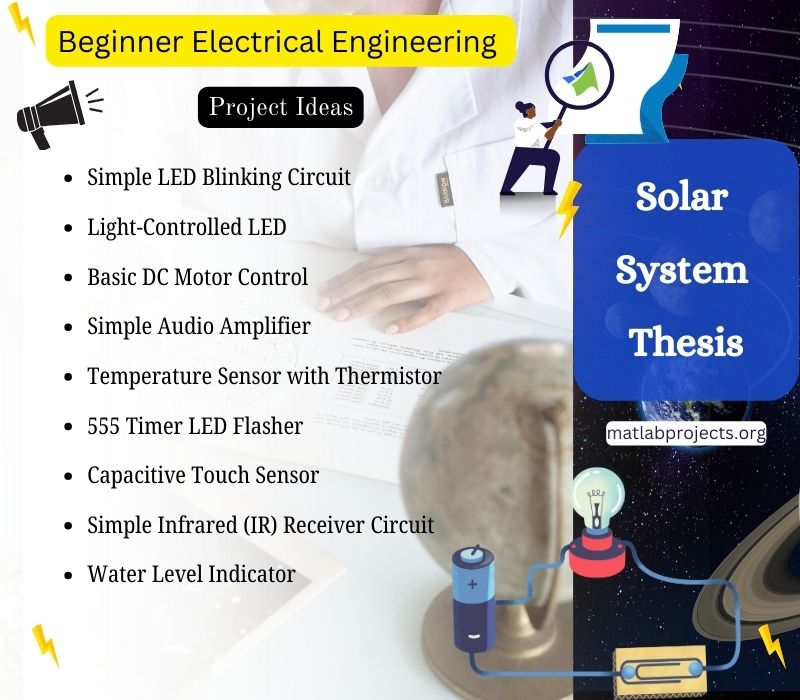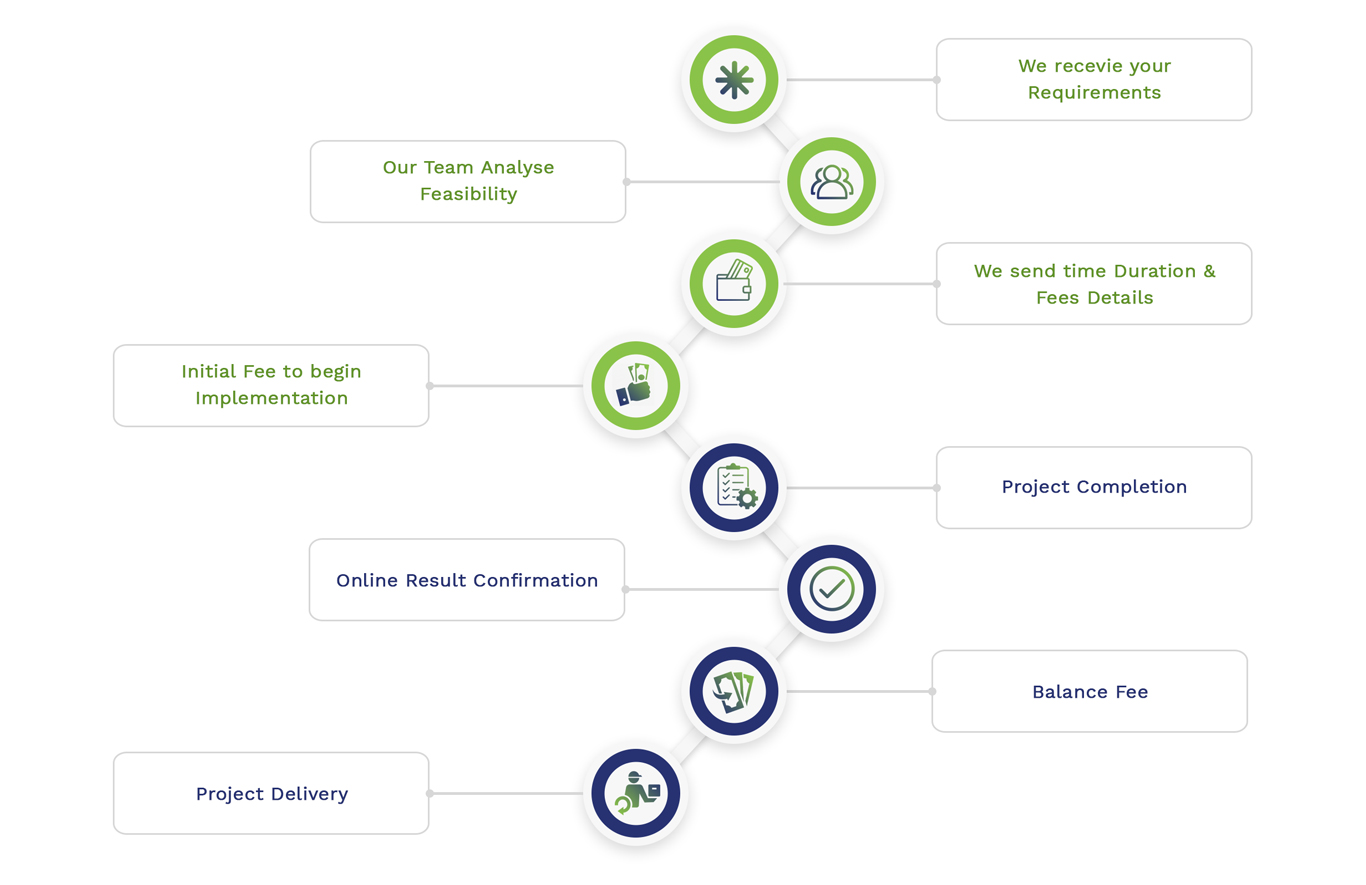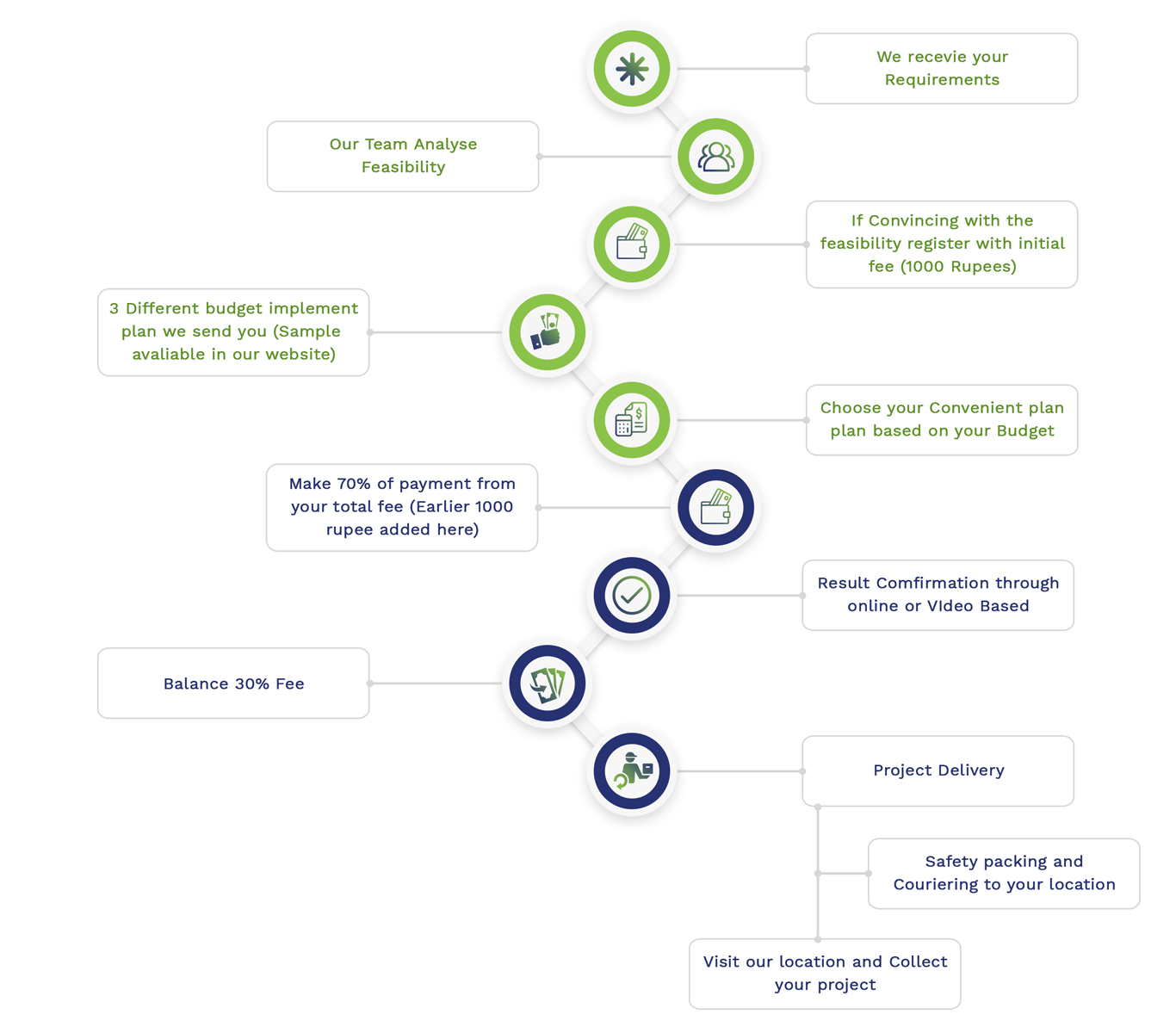Solar System Thesis Proposal is considered as an interesting as well as significant process that includes several important sections. On all domains of solar system, we have worked with and provided excellent research methodologies and simulation part. You can count on our writers for a perfect thesis writing. For writing an extensive solar system thesis proposal, we provide an in-depth structure that assists you in an efficient way:
Thesis Proposal: Development and Analysis of an Efficient Solar Energy System
- Introduction
1.1 Background
Solar energy is examined as one of the major renewable energy sources, which minimize the reliance on fossil fuels and greenhouse gas discharges, and has the capability to fulfill the emerging energy requirements. The significance of enhancing solar energy frameworks for extensive implementation and improved effectiveness is emphasized through the combination of solar power into different platforms and innovations in solar mechanisms.
1.2 Problem Description
In improving the credibility and effectiveness of solar frameworks, issues are still evolving in spite of the advantages of solar energy. An extensive implementation of solar energy is obstructed by different issues like technological problems, changes in ecological states, and combination issues with the previous energy framework. Through creating a solar energy framework in an effective manner and examining its efficiency in various states, this thesis intends to solve all these major issues.
1.3 Goals
- To reduce energy losses and enhance output, we plan to create a solar energy framework.
- In diverse ecological states, the performance of the solar framework has to be examined.
- The ecological implication and economic practicality of the suggested framework must be assessed.
1.4 Research Queries
- What are the major aspects influencing the credibility and performance of solar energy frameworks?
- In what way can solar panels’ effectiveness be improved in various weather states?
- How does the combination of solar energy frameworks affect the previous energy framework?
1.5 Hypotheses
- Through enhancing the position and tilt angle in terms of actual-time ecological data, the effectiveness of solar panels can be optimized in a substantial way.
- The strength and credibility of solar energy frameworks can be improved by the innovative energy storage approaches.
- While enhanced for local contexts, the preliminary investment costs are balanced by the ecological and economic advantages of solar energy frameworks.
- Literature Survey
2.1 Outline of Solar Energy Technologies
Various kinds of solar energy mechanisms have to be studied. It could include solar thermal frameworks, concentrated solar power (CSP), and photovoltaic (PV) frameworks. Their functional standards, challenges, and benefits must be examined.
2.2 Aspects Influencing Solar Panel Efficiency
The major aspects which impact the solar panels’ effectiveness should be analyzed. Some of these aspects are panel position, shading, temperature, and solar irradiance. On the entire performance of the solar frameworks, the effect of every aspect has to be considered.
2.3 Energy Storage Solutions
In solar energy frameworks, the utilized energy storage mechanisms must be studied. It could encompass different techniques like thermal storage, batteries, and supercapacitors. In improving framework effectiveness and credibility, examine their contributions.
2.4 Solar System Integration and Grid Impact
On the basis of combining solar energy frameworks with the previous power grid, investigate the issues and potential solutions. On grid framework, credibility, and strength, the implication of solar energy should be analyzed.
2.5 Economic and Environmental Advantages
By focusing on various aspects like return on investment, cost savings, and minimization in carbon discharges, the ecological advantages and economic practicality of solar energy frameworks have to be assessed.
- Research Methodology
3.1 System Design and Creation
3.1.1 Solar Panel Selection and Layout
In terms of cost, effectiveness, and appropriateness to the focused location, our project chooses ideal solar panels. To enhance energy capture, it models the position and layout of the panels.
Missions:
- Consider various kinds of solar panels and carry out a comparative analysis.
- By examining shading, position, and tilt angle, we plan to model an efficient layout.
3.1.2 Energy Storage Integration
At the time of less sunlight periods, offering a constant power supply is approachable. To store an enormous amount of energy, the energy storage solutions have to be combined with the solar framework.
Missions:
- Various solutions of energy storage must be assessed.
- To match the solar panels, an appropriate energy storage framework has to be modeled.
3.1.3 System Components and Configuration
The choice and arrangement of other major framework elements should be described. It could involve tracking devices, controllers, and inverters.
Missions:
- For effective translation of DC to AC, choose and set up inverters.
- Specifically for tracking and handling the flow of energy, model a control framework.
3.2 Simulation and Analysis
3.2.1 Environmental Data Gathering
To simulate the performance of solar framework in different settings, gather various ecological data such as weather trends, temperature, and solar irradiance.
Missions:
- Focus on obtaining regional atmospheric data or configuring weather stations.
- Actual-time as well as previous ecological data has to be collected.
3.2.2 Performance Simulation
Based on various ecological states, the performance of the solar energy framework must be designed and simulated through the utilization of simulation tools (for instance: PVsyst, MATLAB/Simulink).
Missions:
- For the solar energy framework, we create a simulation model.
- To examine framework performance, execute the simulations. Then, the optimization approaches have to be detected.
3.2.3 Data Analysis and Enhancement
In order to assess the cost-efficiency, credibility, and efficacy of the framework, examine the simulation data. For further enhancement, detect potential areas. Consequently, the model of the framework has to be improved.
Missions:
- To evaluate performance metrics, carry out the statistical analysis process.
- On the basis of the analysis outcomes, enhance the framework arrangement.
3.3 Economic and Environmental Impact Evaluation
3.3.1 Cost-Benefit Analysis
In the solar energy framework, assess its economic practicality such as installation expenses, possible savings, and maintenance by performing an in-depth cost-benefit analysis process.
Missions:
- Concentrate on estimating the functional expenses and preliminary investment.
- Various factors like return on investment and possible savings should be evaluated.
3.3.2 Environmental Impact Assessment
By considering minimizations in energy usage and greenhouse gas discharges, the ecological advantages of the solar energy framework have to be evaluated.
Missions:
- The minimization in ecological implication and carbon footprint has to be examined.
- With conventional energy sources, we compare the effect of the solar energy framework.
3.4 Validation and Testing
3.4.1 Prototype Development
To verify the performance and structure, a model of the solar energy framework must be created.
Missions:
- The model framework has to be created and arranged.
- To gather performance data, carry out field experiments.
3.4.2 Field Testing and Data Gathering
In order to verify the simulation outcomes, the model must be tested in realistic settings. For the further analysis process, collect data.
Missions:
- In a specific test field, configure the model.
- The performance of the framework should be tracked and recorded periodically.
3.4.3 Data Validation
Check the credibility and preciseness of the framework design by comparing the simulation outcomes with the field experiment data.
Missions:
- Focus on examining the data acquired from the field experiment. Then, any contradictions have to be detected.
- On the basis of the validation outcomes, we adapt the framework design.
- Anticipated Results
4.1 Improved Solar System Efficiency
Enhanced solar panel effectiveness leads to greater energy output by means of the improved model and arrangement.
4.2 Credible Energy Storage Integration
To offer a constant power supply and improve framework credibility, this project could suggest an efficient combination of energy storage approaches.
4.3 Economic Feasibility and Environmental Benefits
In terms of the suggested solar energy framework, it can depict the ecological advantages and economic practicality, along with minimized carbon discharges and potential cost savings.
4.4 Validated System Performance
For further exploration and applications, the performance validation of the solar energy framework offers credible data by means of field experiments and simulation.
What beginner electrical engineering projects can I do?
In the field of electrical engineering, numerous project ideas and topics are evolving continuously. Relevant to this field, we suggest a few project plans, including concise explanations, goals, and necessary elements, which could be more appropriate for beginners:
- Simple LED Blinking Circuit
Goal: Through developing a basic circuit which depicts the LED blink, acquire knowledge about the fundamentals of electronics.
Elements:
- LEDs
- Breadboard
- 9V Battery and clip
- Resistors (220Ω)
- Linking wires
Procedures:
- On the breadboard, deploy the LED.
- To a resistor, link the LED’s extended leg (anode).
- The resistor has to be linked to the positive end of the battery.
- To the negative end, link the smaller leg (cathode).
Anticipated Result: This project shows the fundamental circuit principles, which makes the LED blink on and off.
- Basic DC Motor Control
Goal: By utilizing a simple circuit, we plan to regulate the direction and speed of a DC motor.
Elements:
- DC motor
- Switch
- Variable resistor (potentiometer)
- Battery pack (9V)
- Breadboard and wires
- Diode
Procedures:
- Using a switch, the motor must be linked to the battery.
- To regulate the motor’s speed, employ the potentiometer.
- From the back EMF, secure the circuit by appending a diode.
Anticipated Result: By means of this project, the direction and speed of the motor can be regulated.
- Light-Controlled LED
Goal: Focus on developing a circuit, in which a Light Dependent Resistor (LDR) is utilized to turn on the LED in the dark settings.
Elements:
- LDR
- LED
- Transistor (NPN, for example: 2N2222)
- Resistor (10kΩ)
- Breadboard and wires
Procedures:
- In a voltage divider arrangement, link the resistor and LDR.
- To regulate the transistor, employ the voltage divider output.
- Along with the transistor, the LED has to be linked in sequence.
Anticipated Result: When the range of light reduces, the LED will activate.
- Simple Audio Amplifier
Goal: To enhance weak audio signals, we concentrate on developing a simple audio amplifier circuit.
Elements:
- Amplifier IC (for instance: LM386)
- Audio input (for instance: phone)
- Resistor (10kΩ)
- Capacitors (10µF, 220µF)
- Breadboard and wires
- Speaker
Procedures:
- To the amplifier IC, link the audio input.
- For the purpose of coupling and decoupling, include capacitors.
- Then, the output must be linked to the speaker.
Anticipated Result: From the speaker, it could provide an enhanced audio output.
- Temperature Sensor with Thermistor
Goal: Show the temperature on an analog meter by calculating it with a thermistor.
Elements:
- Resistor (10kΩ)
- Thermistor (NTC)
- Battery
- Analog voltmeter
- Breadboard and wires
Procedures:
- In a voltage divider setting, link the resistor and thermistor.
- The output has to be linked to the voltmeter.
- To analyze temperature, regulate the voltmeter.
Anticipated Result: On the basis of the thermistor’s resistance, the temperature could be demonstrated by the voltmeter.
- 555 Timer LED Flasher
Goal: As a means to develop a basic LED flasher circuit, we utilize a 555 timer IC.
Elements:
- Capacitor (10µF)
- 555 Timer IC
- LED
- Breadboard and wires
- Resistors (1kΩ, 10kΩ)
Procedures:
- In a constant mode, set the 555 timer.
- With an LED, link the output.
- To modify the flashing rate, adapt the values of capacitor and resistor.
Anticipated Result: By the control of the 555 timer, the LED could be flashed at fixed intervals.
- Basic Solar-Powered Circuit
Goal: To energize an LED and charge a battery, a basic solar-powered circuit has to be developed.
Elements:
- Diode (1N4001)
- Solar panel (small, 5V)
- Resistor (220Ω)
- Rechargeable battery (AA, 1.2V)
- Breadboard and wires
- LED
Procedures:
- The solar panel must be linked to the battery. To obstruct backflow, include a diode in sequence.
- Corresponding to the battery, integrate the resistor and LED.
Anticipated Result: Through the utilization of energy that is stored in the battery from the solar panel, the LED could be turned on.
- Capacitive Touch Sensor
Goal: In order to regulate an LED, our project aims to create a basic capacitive touch sensor.
Elements:
- Resistor (10MΩ)
- LED
- Capacitor (10nF)
- Breadboard and wires
- 555 Timer IC
Procedures:
- In monostable mode, the 555 timer has to be fixed.
- To develop a touch-aware input, we employ the resistor and capacitor.
- Then, the output should be linked to an LED.
Anticipated Result: When the touch sensor is initiated, the LED will be turned on.
- Simple Infrared (IR) Receiver Circuit
Goal: Concentrate on identifying infrared signals by developing a simple IR receiver circuit.
Elements:
- LED
- IR receiver module (for example: TSOP1738)
- Breadboard and wires
- Battery
- Resistor (220Ω)
Procedures:
- Along with the power supply, link the IR receiver module.
- By means of a resistor, the output must be linked to an LED.
- Using an IR remote control, examine the circuit.
Anticipated Result: While the IR receiver identifies a signal, the LED could be activated.
- Water Level Indicator
Goal: By employing LEDs and transistors, we plan to build a basic water level indicator.
Elements:
- LEDs
- Conductive probes
- Transistors (NPN, for instance: 2N2222)
- Breadboard and wires
- Resistors (10kΩ)
- Battery
Procedures:
- At various water levels, deploy the conductive probes.
- Using resistors, the probes have to be linked to the base of transistors.
- To an LED and power supply, join the collector of every transistor.
Anticipated Result: As water touches every probe, the LEDs will be turned on to denote the water level.
- Simple Digital Voltmeter
Goal: Our project utilizes a microcontroller to model a simple digital voltmeter.
Elements:
- Voltage divider resistors
- Microcontroller (for example: Arduino)
- Breadboard and wires
- LCD display
Procedures:
- The voltage divider has to be linked to the analog input of the microcontroller.
- To depict the voltage on the LCD by analyzing it, set the microcontroller.
- For precise readings, regulate the voltmeter.
Anticipated Result: On the LCD, the voltage readings can be exhibited through digital voltmeter.
- Build a Simple FM Radio
Goal: Employ the instantly accessible elements to create a simple FM radio receiver.
Elements:
- Capacitors and resistors
- Battery
- TDA7000 FM radio IC
- Breadboard and wires
- Speaker
Procedures:
- In accordance with the datasheet, integrate the TDA7000 IC.
- Then, the output should be linked to a speaker.
- To modify across FM radio stations, adapt the circuit.
Anticipated Result: The FM radio stations can be acquired and played by the circuit.

Solar System Thesis Proposal
Solar System Thesis Proposal topics that we assisted for all stages of scholars are shared by matlabprojects.org team. For Solar System Thesis Proposal writing we follow your university rules, all the work will be open to you necessary corrections can be made. Our writers present your paper with necessary diagrams, charts and columns for neat presentation. Stay in touch with our panel.
- Comparison and design of power electronics transformers in 25 kHz–400 kHz range
- Characterization of power electronics system interconnect parasitics using time domain reflectometry
- A systematic design approach to thermal-electrical power electronics integration
- A wavelet method for signal analyses of the power electronics circuits
- Comparative Analysis of Boost DC-DC Converters with Application in Power Electronics Education
- Power Devices Embedded Printed Circuit Broads for Future Highly Integrated Power Electronics
- Analysis and evaluation of near field noise voltage on power electronics circuits
- Advanced design tools for the lifetime of power electronics – study case on motor drive application
- Improving the voltage stability and performance of power networks using power electronics based FACTS controllers
- Single Active Switch Power Electronics for Kilowatt Scale Capacitive Power Transfer
- Analysis and Suppression of Inductive Interference in Active Integrated Power Electronics Module
- Reduction of magnetic field strength on PCB level laboratory for power electronics students
- A power electronics controlled current source based on a multi-converter topology
- Teaching Power Electronics with the Aid of Open Source Simulation Tool eSim
- Power electronics devices modeling by traditional equivalent circuit and black-box theory
- Advanced packaging technologies for fully exploiting attributes of WBG power electronics
- A novel approach to integrate computer exercises into teaching of utility-related applications of power electronics
- An apparatus for loss measurement of integrated power electronics modules: design and analysis
- Selection of Digital Controller for Power System and Power Electronics Applications
- Review on Role of Power Electronics in Integration of Renewable Energy Sources with Micro grid
Subscribe Our Youtube Channel
You can Watch all Subjects Matlab & Simulink latest Innovative Project Results
Our services
We want to support Uncompromise Matlab service for all your Requirements Our Reseachers and Technical team keep update the technology for all subjects ,We assure We Meet out Your Needs.
Our Services
- Matlab Research Paper Help
- Matlab assignment help
- Matlab Project Help
- Matlab Homework Help
- Simulink assignment help
- Simulink Project Help
- Simulink Homework Help
- Matlab Research Paper Help
- NS3 Research Paper Help
- Omnet++ Research Paper Help
Our Benefits
- Customised Matlab Assignments
- Global Assignment Knowledge
- Best Assignment Writers
- Certified Matlab Trainers
- Experienced Matlab Developers
- Over 400k+ Satisfied Students
- Ontime support
- Best Price Guarantee
- Plagiarism Free Work
- Correct Citations
Expert Matlab services just 1-click

Delivery Materials
Unlimited support we offer you
For better understanding purpose we provide following Materials for all Kind of Research & Assignment & Homework service.
 Programs
Programs Designs
Designs Simulations
Simulations Results
Results Graphs
Graphs Result snapshot
Result snapshot Video Tutorial
Video Tutorial Instructions Profile
Instructions Profile  Sofware Install Guide
Sofware Install Guide Execution Guidance
Execution Guidance  Explanations
Explanations Implement Plan
Implement Plan
Matlab Projects
Matlab projects innovators has laid our steps in all dimension related to math works.Our concern support matlab projects for more than 10 years.Many Research scholars are benefited by our matlab projects service.We are trusted institution who supplies matlab projects for many universities and colleges.
Reasons to choose Matlab Projects .org???
Our Service are widely utilized by Research centers.More than 5000+ Projects & Thesis has been provided by us to Students & Research Scholars. All current mathworks software versions are being updated by us.
Our concern has provided the required solution for all the above mention technical problems required by clients with best Customer Support.
- Novel Idea
- Ontime Delivery
- Best Prices
- Unique Work
Simulation Projects Workflow

Embedded Projects Workflow



 Matlab
Matlab Simulink
Simulink NS3
NS3 OMNET++
OMNET++ COOJA
COOJA CONTIKI OS
CONTIKI OS NS2
NS2






